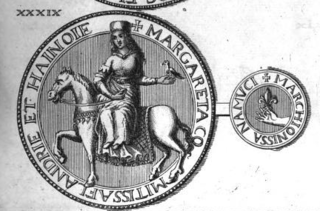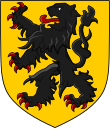
Baldwin I was the first Emperor of the Latin Empire of Constantinople; Count of Flanders from 1194 to 1205 and Count of Hainaut from 1195 to 1205. Baldwin was one of the most prominent leaders of the Fourth Crusade, which resulted in the sack of Constantinople in 1204, the conquest of large parts of the Byzantine Empire, and the foundation of the Latin Empire. He lost his final battle to Kaloyan, the emperor of Bulgaria, and spent his last days as his prisoner.

Godfrey of Bouillon was a pre-eminent leader of the First Crusade, and the first ruler of the Kingdom of Jerusalem from 1099 to 1100, although he avoided the title of king, preferring that of prince (princeps) and Advocatus Sancti Sepulchri, or Advocate of the Holy Sepulchre. He was the second son of Eustace II, Count of Boulogne, and Lord of Bouillon, from his mother's inheritance, in 1076. In 1087 Emperor Henry IV confirmed him as Duke of Lower Lorraine, a reward for his support during the Great Saxon Revolt. Along with his brothers Eustace III and Baldwin of Boulogne, Godfrey joined the First Crusade in 1096. He took part in actions at Nicaea, Dorylaeum, and Antioch, before playing a key role during the capture of Jerusalem in 1099. When Raymond IV, Count of Toulouse declined the offer to become ruler of the new kingdom, Godfrey accepted the role and secured his kingdom by defeating the Fatimids at Ascalon a month later, bringing the First Crusade to an end. He died in July 1100 and was succeeded by his brother Baldwin as King of Jerusalem.
Eustace I, Count of Boulogne, was a nobleman and founder of the Boulogne branch of the House of Flanders. He held the county of Boulogne from 1024 until his death in 1047.

Theoderic, commonly known as Thierry of Alsace, was the fifteenth count of Flanders from 1128 to 1168. With a record of four campaigns in the Levant and Africa, he had a rare and distinguished record of commitment to crusading.

Arnulf I, called "the Great", was the first Count of Flanders.

Robert I, known as Robert the Frisian, was count of Flanders from 1071 until his death in 1093. He was a son of Baldwin V, Count of Flanders, and the younger brother of Baldwin VI, Count of Flanders. He usurped the countship after defeating his nephew Arnulf III and his allies, which included King Philip I of France, Count Eustace of Boulogne and the counts of Saint-Pol and Ardres at the Battle of Cassel. He subsequently made peace with Philip, who became his stepson-in-law, but remained hostile to his sister Matilda and her husband William the Conqueror, who was king of England and duke of Normandy.

Margaret I was the countess of Flanders suo jure from 1191 to her death.

The County of Boulogne was a county within the Kingdom of France during the 9th to 15th centuries, centred on the city of Boulogne-sur-Mer. It was ruled by the counts of Flanders in the 10th century, but a separate House of Boulogne emerged during the 11th century. It was annexed by Philip II of France in 1212, after which it was treated as part of the county of Artois until it was finally annexed into the royal domain in 1550.

The County of Hainaut, sometimes spelled Hainault, was a territorial lordship within the medieval Holy Roman Empire that straddled the present-day border of Belgium and France. Its most important towns included Mons, now in Belgium, and Valenciennes, now in France.
Arnulf III was Count of Flanders from 1070 until his death at the Battle of Cassel in 1071.
Baldwin II (1056–1098?) was count of Hainaut from 1071 to his death. He was an unsuccessful claimant to the County of Flanders. He disappeared in Anatolia during the First Crusade.

Dirk V was Count of Holland from 1061 to 1091.
Sibylla of Anjou was a countess consort of Flanders as the wife of Thierry, Count of Flanders. She served as the regent of Flanders during the absence of her spouse from 1147 to 1149.
Richilde, Countess of Mons and Hainaut, was a ruling countess of Hainaut from c. 1050 until 1076, in co-regency with her husband Baldwin VI of Flanders and then her son Baldwin II of Hainaut. She was also countess of Flanders by marriage to Baldwin VI between from 1067 to 1070. She ruled Flanders as regent during the minority of her son Arnulf III in 1070–1071.

The Count of Hainaut was the ruler of the county of Hainaut, a historical region in the Low Countries. In English-language historical sources, the title is often given the older spelling Hainault.
The Battle of Cassel was fought in February 1071 between Robert I of Flanders and his nephew, Arnulf III. The battle was a victory for Robert, and Arnulf was killed in the battle.
Henry II was the Count of Louvain (Leuven) from 1054 through 1071 (?). Henry II was the son of Lambert II, Count of Louvain and Oda of Verdun. His maternal uncles included Pope Stephen IX and Duke Godfrey the Bearded of Lorraine.

Count of Boulogne was a historical title in the Kingdom of France. The city of Boulogne-sur-Mer became the centre of the county of Boulogne during the ninth century. Little is known of the early counts, but the first holder of the title is recorded in the 11th century.
The army of Godfrey of Bouillon, the duke of Lower Lorraine, in response to the call by Pope Urban II to both liberate Jerusalem from Muslim forces and protect the Byzantine Empire from similar attacks. Godfrey and his army, one of several Frankish forces deployed during the First Crusade, was among the first to arrive in Constantinople. The army was unique in that it included among its warriors the first three kings of Jerusalem, although Godfrey preferred the title Defender of the Holy Sepulchre, Advocatus Sancti Sepulchri, as he believed that the true King of Jerusalem was Christ. This article focuses on the members of the army rather that its exploits which are described in detail in Godfrey’s biography as well as numerous sources listed below.


















